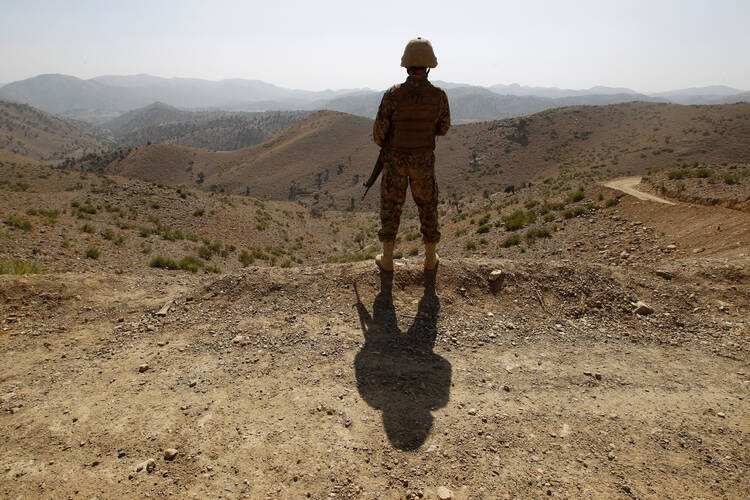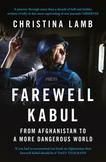Afghanistan: the war we should still care about
Does anyone care?
Christina Lamb asked herself this question as she watched the final flag-lowering of the British contingent at Camp Bastion in Helmand Province, Afghanistan, in October 2014. A quarter of a century had passed since she reported on the Soviet withdrawal from the same country.
Someone still cares. In April 2017 a massive ordnance air blast bomb was dropped in Afghanistan’s Nangarhar Province. That same month over 100 Afghan government soldiers were killed on their own base while the U.S. secretary of defense was making an unannounced visit to NATO and U.S. troops in the country.
The continued costs and casualties alone should lead parents, taxpayers and indeed politicians to care. I still care. One of my sons is a soldier. My own interest goes back to 1989, when I first met Christina Lamb in Kabul while I was an unarmed military observer with the United Nations Good Offices Mission in Afghanistan and Pakistan. Farewell Kabul is an outstanding but disturbing read. In 640 pages, with photos and maps, Lamb “sets out to tell the story, from someone who lived through it, of how we turned success into defeat.” The “we,” I think, stands for nations who contributed to the foreign interventions in Afghanistan from 9/11 to the present. I should add that I do not consider Pakistan as one of these nations.
The continued costs and casualties alone should lead parents, taxpayers and indeed politicians to care.
Since the Soviet invasion of 1979, Pakistan has been a persistent presence in Afghanistan. The country has been a “necessary” ally while remaining a longstanding supporter of the Taliban. Pakistan also provided refuge for Osama bin Laden, who in his final days nestled next to some of their key military institutions.
Pakistani generals who devoted their careers to supporting our enemies also profited from ownership of the trucks that supplied our contingents. Few chapters in this book are untainted by the “odour” of Pakistan’s Inter Service Intelligence, a mentor and major ally of the Taliban. Voices ranging from the president of Afghanistan to a village elder in Helmand are cited by Lamb, who sees Pakistan as a foe. American generals and soldiers at the front lines are quoted to the same effect.
The chapter “Meeting Colonel Imam” reveals a Pakistani army officer whose whole career has been dedicated to support of the mujahedin and the Taliban. The Taliban and officers like Col. Imam do not work on the same, limited timelines as the 17 British commanders in Helmand, who served on six-month deployments.
Lamb has been reporting on Afghanistan for her whole career as a journalist, so readers are well-served by her observations. Another book of hers, primarily on Pakistan, was published in 1991. She provides unique content through her connections and her courage. It was a connection with Benazir Bhutto and the invitation to her wedding that brought the author to Pakistan in 1987, and thus Afghanistan. It was her courage that put her on Bhutto’s bus when it was demolished by a car bomb in October 2007. Her coverage had her deported from Pakistan, twice, and made her no longer authorized to accompany British troops in Helmand coming in contact with the Taliban for a period of two years.
Lamb has been reporting on Afghanistan for her whole career as a journalist.
The reader has a menu of content from which to choose, depending on whether tactical close combat, operational level decisions or strategic planning and preparation are the area of interest. The chapter “Tethered Goats” details the military strategy and combat in the town of Sangin in the summer of 2006.
The BBC reported the fall of Sangin to the Taliban on March 23, 2017. Over 100 British soldiers died there. Major Pike, who commanded the company that Lamb found fighting there, “was so disillusioned that he left the army” upon his return to Britain. Pike thought the overextension of the limited number of combat soldiers led to extreme violence to save soldiers’ lives. The end result was destruction, not the reconstruction called for by Britain’s strategy.
It was not for lack of resources. Camp Bastion, the main British base in Helmand, was the United Kingdom’s first billion-dollar base anywhere and for a time was the third busiest British airport. Lamb was also embedded with British troops in Helmand and with American forces in places like Shkin. Sadly, she reports that President Karzai, when questioned, said that it would have been better if the British had never gone to Helmand. I suppose that this comment also applies to the American marines who supported the British near the end of their tour.
All the four parts of this account have chapters with labels suggesting that Pakistan was behind the range of hostile activities that made so many of those on the ground consider that country—or at least certain people in power—an “enemy.” The chapter about Quetta, Pakistan, says it all: “Taliban Central.” Among the photos that illustrate this volume is a picture of U.S. Major Larry Bauguess Jr. beside a group of Pakistani soldiers, including the one who later killed him. First reported as occurring in Afghanistan, the shooting of this U.S. major was deliberate, during so-called negotiations on the Pakistan side of the frontier.
A critical query is posed by the Estonian Foreign Ministry undersecretary and nonresident ambassador to Afghanistan while visiting the small Estonian contingent in Helmand. “What are we doing here?” he asks. We must all answer this question. It may change the ending of Christine Lamb’s next book on Afghanistan.
This article also appeared in print, under the headline “A forgotten war,” in the January 8, 2018, issue.











